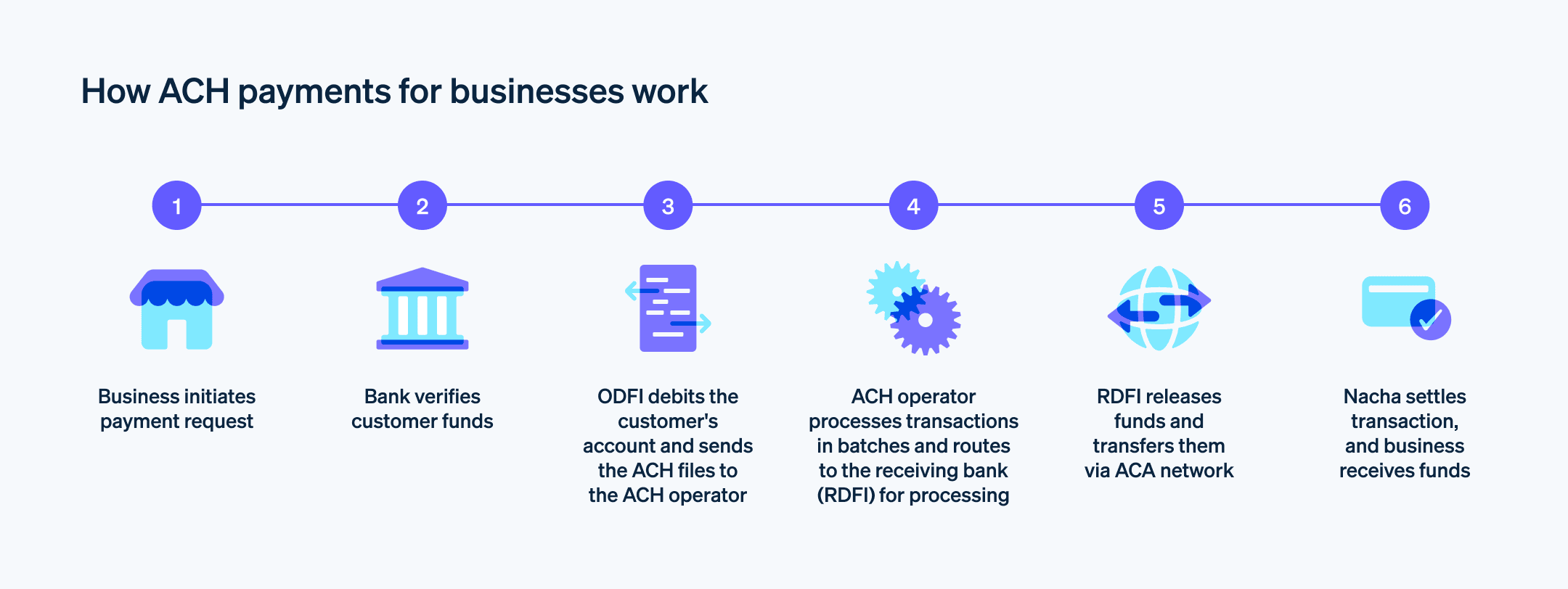หากคุณเคยได้รับเงินเดือนด้วยการฝากบัญชีอัตโนมัติหรือชําระบิลค่าสาธารณูปโภคจากบัญชีธนาคารของคุณโดยตรง โดยใช้หมายเลขบัญชีและ Routing Number คุณก็คุ้นเคยกับการชําระเงินแบบ ACH ในฐานะบุคคลทั่วไปอยู่แล้ว แต่การรับชําระเงินแบบ ACH ในฐานะธุรกิจล่ะ
ACH เป็นวิธีการประมวลผลการชําระเงินที่มีค่าใช้จ่ายไม่มาก เชื่อถือได้ และปลอดภัย โดยจะช่วยให้ลูกค้าซื้อสินค้าในราคาสูงได้โดยไม่ต้องกังวลเกี่ยวกับวงเงินใช้จ่ายผ่านบัตรเครดิต การโอนเงินแบบ ACH เป็นวิธีที่ง่ายสําหรับธุรกิจในการลดเวลาและค่าใช้จ่ายที่ใช้ไปกับการประมวลผลธุรกรรม ทั้งสําหรับธุรกรรมแบบเฉพาะเจาะจงและการชําระเงินตามแบบแผนล่วงหน้า
บทความนี้จะอธิบายถึงสิ่งที่คุณควรทราบเกี่ยวกับการชําระเงินแบบ ACH ตั้งแต่วิธีการทํางานของการโอนเงินแบบ ACH ไปจนถึงประโยชน์ของการยอมรับ ACH เป็นวิธีการชําระเงินสําหรับธุรกิจของคุณ
บทความนี้ให้ข้อมูลอะไรบ้าง
- ACH ย่อมาจากอะไร
- การชําระเงินแบบ ACH คืออะไร
- การโอนเงินแบบ ACH ใช้เวลานานเท่าใด
- ใครคือผู้ที่ใช้การชําระเงินแบบ ACH
- ธุรกรรม ACH ประเภทต่างๆ มีอะไรบ้าง
- การฝากบัญชีอัตโนมัติแบบ ACH
- การชำระเงินอัตโนมัติแบบ ACH
- การฝากบัญชีอัตโนมัติแบบ ACH
- วิธีการทํางานของการชําระเงินแบบ ACH
- วิธีทำการชําระเงินแบบ ACH
- วิธีรับการชําระเงินแบบ ACH ในฐานะธุรกิจ
- การรับการชําระเงินแบบ ACH ในฐานะธุรกิจมีค่าใช้จ่ายเท่าใด
- การชําระเงินแบบ ACH แตกต่างจากการโอนเงินระหว่างธนาคารอย่างไร
- การโอนเงินแบบ ACH คือสิ่งเดียวกับ EFT หรือไม่
- ประโยชน์ของการชําระเงินแบบ ACH สำหรับธุรกิจ
ACH ย่อมาจากอะไร
ACH ย่อมาจากสํานักหักบัญชีอัตโนมัติ (Automated Clearing House) สํานักหักบัญชีอัตโนมัติ คือเครือข่ายการเงินแบบรวมศูนย์ในสหรัฐอเมริกาที่ใช้ในการส่งและรับชําระเงินทางอิเล็กทรอนิกส์ รวมทั้งการโอนเงินสําหรับธนาคารและสหภาพเครดิต
การชําระเงินแบบ ACH คืออะไร
การชําระเงินแบบ ACH คือการโอนเงินระหว่างบัญชีของสถาบันทางการเงินที่แตกต่างกัน ซึ่งใช้เครือข่าย ACH
เครือข่าย ACH ได้รับการดูแลโดยสมาคมสํานักหักบัญชีอัตโนมัติแห่งชาติ (Nacha) ซึ่งเป็นองค์กรอิสระที่มีธนาคาร สหภาพเครดิต และบริษัทประมวลผลการชําระเงินกลุ่มใหญ่เป็นเจ้าของ สถาบันการเงินของ Nacha ให้บริการวิธีการโอนเงินระหว่างบัญชีที่ธนาคารต่างๆ โดยตรงโดยไม่ต้องใช้เช็คกระดาษ โอนเงินทางโทรเลข บัตรเครดิตหรือเงินสด
การโอนเงินแบบ ACH ใช้เวลานานเท่าใด
แม้ว่าการโอนเงินแบบ ACH เคยใช้เวลาโดยเฉลี่ย 3-5 วันทําการจึงจะถึงปลายทาง แต่ในปัจจุบัน เครือข่าย ACH ก็มีตัวเลือกในการประมวลผลเครดิต ACH แบบทำการชำระเงิน "ในวันเดียวกัน" "ในวันถัดไป" หรือ "ใน 2 วัน"
คนส่วนใหญ่คิดว่าการโอนเงินแบบ ACH ช้ากว่าวิธีการชําระเงินแบบอิเล็กทรอนิกส์อื่นๆ แต่ปัจจุบันกลับไม่เป็นเช่นนั้น เมื่อวันที่ 19 มีนาคม 2021 การเปลี่ยนแปลงกฎการดําเนินงานของ Nacha ขยายการเข้าถึงธุรกรรม ACH แบบภายในวันเดียวกัน ซึ่งช่วยให้ธุรกรรม ACH ส่วนใหญ่มีการชำระเงินภายในวันเดียวกัน
สําหรับการฝากบัญชีอัตโนมัติ นายจ้างส่วนมากจะเริ่มต้นการชําระเงินล่วงหน้า 2-3 วันก่อนวันจ่ายเงิน เพื่อให้เงินดังกล่าวพร้อมใช้ในบัญชีของผู้รับภายในเวลา 9.00 น. ของวันนั้น
ใครคือผู้ที่ใช้การชําระเงินแบบ ACH
ในปี 2020 เครือข่าย ACH ประมวลผลการชําระเงินถึง 2.68 หมื่นล้านรายการ การชําระเงินแบบ ACH สามารถใช้กับธุรกรรมได้หลากหลายรูปแบบ ประเภทของการชําระเงินแบบ ACH มีดังนี้
- ใบเรียกเก็บเงินสําหรับผู้บริโภค
- การคืนเงินภาษี
- การชําระภาษี
- เงินสมทบเข้าบัญชีเกษียณและลงทุน
- การซื้อเชิงพาณิชย์
- การบริจาคเงินเพื่อการกุศล
- การชําระเงินค่าเทอมสําหรับสถานศึกษา
- เงินที่ส่งระหว่างครอบครัวและเพื่อนๆ
ธุรกรรม ACH ประเภทต่างๆ มีอะไรบ้าง
การโอนเงินแบบ ACH แบ่งออกเป็น 2 หมวดหมู่ ได้แก่ การฝากบัญชีอัตโนมัติและการชําระเงินอัตโนมัติ นี่คือภาพรวมของความแตกต่างระหว่างหมวดหมู่เหล่านี้
การฝากบัญชีอัตโนมัติแบบ ACH
การฝากบัญชีอัตโนมัติคือการโอนเงินประเภทใดก็ได้จากหน่วยงานของรัฐหรือธุรกิจไปยังผู้บริโภค ประเภทของการฝากเงินโดยตรงประกอบด้วยสิ่งต่อไปนี้
- ค่าจ้างของพนักงาน
- เงินเบิกคืนจากนายจ้างสำหรับค่าใช้จ่ายที่เกี่ยวข้องกับงาน
- สวัสดิการของรัฐบาล
- การคืนเงินภาษี
- เงินรายปีและดอกเบี้ย
หากคุณเป็นหนึ่งใน 93% ของชาวอเมริกันที่ได้รับเงินค่าจ้างผ่านการฝากบัญชีอัตโนมัติ ก็มีโอกาสสูงที่เงินดังกล่าวจะส่งเป็นการโอนเงินแบบ ACH หากค่าจ้างของคุณมีการแบ่งยอดและฝากเงินไปยัง 2 บัญชีขึ้นไปโดยอัตโนมัติเมื่อคุณได้รับค่าจ้าง ก็จะเรียกว่า "การแบ่งฝาก" การแบ่งฝากจะเกิดขึ้นผ่านเครือข่าย ACH เช่นกัน
การชำระเงินอัตโนมัติแบบ ACH
การชำระเงินอัตโนมัติเป็นอีกประเภทหนึ่งของการโอนเงินทางอิเล็กทรอนิกส์ผ่านเครือข่าย ACH การชำระเงินอัตโนมัติ ซึ่งแตกต่างจากการฝากเงินเข้าบัญชีอัตโนมัติที่มีการโอนเงินเข้าบัญชีของคุณ จะเป็นการโอนเงินแบบ ACH ที่คุณโอนออกจากบัญชี เช่น การชําระเงินตามใบเรียกเก็บ
วิธีการทำงานของการชำระเงินแบบ ACH
สถาบันต่อไปนี้มีส่วนทำให้การชำระเงินแบบ ACH เกิดขึ้น
National Automated Clearing House Association
Nacha เป็นองค์กรที่ดำเนินงานโดยรัฐบาลและไม่ฝักใฝ่ฝ่ายใด ซึ่งมีหน้าที่รับผิดชอบในการบริหารจัดการเครือข่าย ACHOriginating Depository Financial Institution (ODFI)
ODFI เป็นสถาบันธนาคารที่ออกคำขอโอนเงินแบบ ACHReceiving Depository Financial Institution (RDFI)
RDFI เป็นสถาบันธนาคารที่รับคำขอ ACH
ODFI จะส่งคำขอไปยัง RDFI เพื่อโอนเงิน สถาบันธนาคารทั้งสองแห่งจะตรวจสอบกันและกันเพื่อให้แน่ใจว่ามีเงินในบัญชีขาออกเพียงพอ และหากมีเงินเพียงพอ ระบบก็จะทำการโอนเงิน
เมื่อถึงจุดนี้ ODFI จะรวบรวมไฟล์ที่มีข้อมูลสำคัญทั้งหมดเกี่ยวกับคำขอโอนเงิน ซึ่งประกอบด้วยข้อมูลดังต่อไปนี้
- ประเภทธุรกรรม (การฝากเงินเข้าบัญชีหรือการหักบัญชี)
- Routing Number
- หมายเลขบัญชี
- จำนวนเงินที่จะโอน
ODFI จะรวบรวมคำขอโอนเงินแบบ ACH ทั้งหมดภายในระยะเวลาที่กำหนดเป็นชุดและส่งไฟล์ต่างๆ ที่รวมเป็นชุดไว้นั้นไปยังผู้ให้บริการ ACH ซึ่งจะส่งไฟล์นั้นไปยัง RDFI ธนาคารที่มีการถอนเงินก็จะปล่อยเงินดังกล่าวออก ซึ่งเงินจะส่งผ่านเครือข่าย ACH เพื่อฝากเข้าในบัญชีปลายทาง
RDFI แม้ว่าจะมีคำว่า “รับ” (Receiving) อยู่ในชื่อ แต่ก็ไม่ได้เป็นธนาคารที่รับเงินในการชำระเงินแบบ ACH เสมอไป แต่ธนาคารนี้จะได้รับคำขอให้เริ่มการโอนเงินผ่านเครือข่าย ACH ส่วน ODFI (ซึ่งเป็นสถาบันที่เริ่มส่งคำขอรับเงิน) มักจะเป็นฝ่ายที่ได้รับเงินในท้ายที่สุด ขอให้นึกถึงคำว่า "เริ่ม" (Originating) และ "รับ" (Receiving) เอาไว้โดยเชื่อมโยงกับคำขอ ACH ไม่ใช่ตัวเงิน
Nacha จะรวมการโอนเงินทั้งหมดที่ดำเนินการผ่านเครือข่าย ACH ภายในช่วงเวลาที่กำหนด ซึ่งมักจะอยู่ที่ประมาณ 6 ชั่วโมงในระหว่างวันทำการ จากนั้นจะชำระเงินให้กับคำขอแต่ละชุดในหลายช่วงเวลาตลอดทั้งวันนั้นๆ

วิธีทำการชําระเงินแบบ ACH
การชําระเงินแบบ ACH สามารถดําเนินการผ่านพอร์ทัลสมาชิกออนไลน์ของสถาบันการเงินส่วนใหญ่หรือทางโทรศัพท์ ข้อมูลเดียวที่คุณมักต้องใช้คือจํานวนเงินที่ส่ง รวมถึง Routing Number และหมายเลขบัญชีของผู้รับ
วิธีรับชําระเงินแบบ ACH ในฐานะธุรกิจ
ขั้นตอนในการรับการชําระเงินแบบ ACH สําหรับธุรกิจของคุณมีดังนี้
- สมัครบัญชีธนาคารสําหรับธุรกิจของคุณ หากยังไม่มี หากมีบัญชีผู้ค้ากับผู้ให้บริการประมวลผลการชําระเงิน คุณอาจจะยอมรับการชําระเงินผ่านผู้ค้ารายดังกล่าวได้เช่นกัน
- อัปเดตขั้นตอนการชําระเงินเพื่ออนุญาตให้ใช้การชำระเงินแบบ ACH เนื่องจากปกติแล้วขั้นตอนการชําระเงินเหล่านี้จะไม่เป็นส่วนหนึ่งของตัวเลือกการชําระเงินออนไลน์แบบมาตรฐาน ผู้ให้บริการแก่ผู้ค้าสามารถแนะนำคุณถึงวิธีที่ดีที่สุดในการดําเนินการขั้นตอนนี้
- ส่งหนังสือมอบอํานาจให้กับลูกค้า ซึ่งเป็นเอกสารเพื่อขอความยินยอมให้ธุรกิจของคุณเริ่มส่งคําขอ ACH จากธนาคารของลูกค้า
- รวบรวมรายละเอียดบัญชีของลูกค้าและเริ่มส่งคําขอ ACH แม้ว่าลูกค้าจะเป็นผู้เริ่มการชําระเงินแบบ ACH ได้ แต่ส่วนใหญ่แล้วธุรกิจจะเป็นฝ่ายดำเนินการ
ลูกค้า Stripe สามารถเริ่มการหักบัญชีอัตโนมัติแบบ ACHเป็นวิธีการชําระเงิน ลูกค้าให้ข้อมูลบัญชีธนาคาร และธุรกิจสามารถดึงเงินจากบัญชีของพวกเขาได้โดยตรง ไม่ว่าจะสำหรับการซื้อแบบครั้งเดียวหรือการชำระเงินตามแบบแผนล่วงหน้า สําหรับธุรกิจที่ใช้ Stripe คุณสามารถจัดการการหักบัญชีแบบ ACH เหล่านี้ได้ในแดชบอร์ด
ผู้ให้บริการประมวลผลการชําระเงินบางราย เช่น Stripe เสนอบริการเพิ่มเติมเกี่ยวกับการชําระเงินแบบ ACH เช่น ตัวเลือกในการฝากเงินจํานวนเล็กน้อย เงินฝากจํานวนเล็กน้อยเป็นเงินจํานวนน้อยมาก (โดยปกติจะไม่กี่เซ็นต์) ที่ส่งไปยังบัญชีธนาคาร จากนั้นก็ดึงกลับมาโดยใช้เครือข่าย ACH เพื่อยืนยันรายละเอียดบัญชีก่อนที่จะพยายามทําธุรกรรมจริง
การรับการชำระเงินแบบ ACH ในฐานะธุรกิจมีค่าใช้จ่ายเท่าใด
ค่าใช้จ่ายในการใช้การชำระเงินแบบ ACH จะแตกต่างกันไป โดยขึ้นอยู่กับผู้ให้บริการที่คุณใช้ประมวลผลการชำระเงิน การชำระเงินแบบ ACH บน Stripe มีค่าธรรมเนียม 0.80% สูงสุดที่ 5.00 ดอลลาร์สหรัฐโดยไม่มีค่าธรรมเนียมรายเดือน ดังนั้นการชำระเงิน 100.00 ดอลลาร์สหรัฐ จะมีค่าธรรมเนียม 0.80 ดอลลาร์สหรัฐ และการชำระเงินที่มีมูลค่าสูงกว่า 625.00 ดอลลาร์สหรัฐ จะมีค่าใช้จ่าย 5.00 ดอลลาร์สหรัฐ. โมเดลค่าบริการนี้จะมีประโยชน์อย่างยิ่งหากคุณเรียกเก็บเงินจำนวนสูงจากลูกค้าตามแบบแผนล่วงหน้าเป็นประจำ
หากคุณใช้บริการการตรวจสอบบัญชีของ Stripe เช่น Financial Connections อาจมีค่าธรรมเนียมเพิ่มเติม โปรดดูรายละเอียดเพิ่มเติมในหน้า "ค่าบริการของ Stripe"
การชําระเงินแบบ ACH แตกต่างจากการโอนเงินระหว่างธนาคารอย่างไร
แม้ทั้งการชําระเงินแบบ ACH และการโอนเงินระหว่างธนาคารจะเกี่ยวข้องกับการเคลื่อนย้ายเงินระหว่างบัญชีในสถาบันการเงินต่างๆ แต่ทั้งสองตัวเลือกมีความแตกต่างที่สําคัญ 4 ประการ ดังนี้
|
การโอนเงินแบบ ACH
|
การโอนเงินระหว่างธนาคาร
|
|
|---|---|---|
|
เครือข่าย
|
National Automated Clearing House Association (Nacha) | บริการเงินทุน Fedwire |
|
ความเร็ว
|
1-4 วัน | ไม่กี่ชั่วโมงและไม่เกิน 2 วัน |
|
ภูมิศาสตร์
|
สหรัฐอเมริกาและเปอร์โตริโก | การชำระเงิน |
|
ค่าใช้จ่าย
|
มักจะฟรี หรืออาจไม่กี่ดอลลาร์ |
ในประเทศ: ไม่เกิน $35
ต่างประเทศ: $35-50 |
เครือข่าย
การชําระเงินแบบ ACH ใช้เครือข่าย Nacha เพื่อส่งเงินจากบัญชีที่ออกไปยังบัญชีที่รับ การโอนเงินระหว่างธนาคารใช้บริการเงินทุนของ Fedwire
ความเร็ว
ในอดีต การโอนเงินผ่านธนาคารมักจะเร็วกว่าการโอนเงินแบบ ACH แต่กลับไม่เป็นเช่นนั้นอีกต่อไปเนื่องจากการเปลี่ยนแปลงกฎของ Nacha เวลาในการโอนจะแตกต่างกันไปเนื่องจากวิธีที่เครือข่าย ACH และ Fedwire ชำระเงินโอน
เครือข่าย ACH จะประมวลผลการชําระเงินเกือบตลอดเวลา 23 ¼ ชั่วโมง ทุกวันทําการ เงินที่ส่งผ่านเครือข่าย ACH จะได้รับการชําระเงิน ซึ่งหมายถึงการย้ายไปที่บัญชีปลายทางวันละ 4 ครั้ง เงินอาจถูกส่งช้าสุดในเวลา 2:15 น. ET สำหรับการชำระเงินที่ดำเนินการในเวลา 8:30 น. ET นอกจากนี้ ยังมีกําหนดเวลาการประมวลผล ACH แบบในวันเดียวกันอีก 3 ครั้งตลอดทั้งวัน
การชำระเงินจะได้รับการดำเนินการในวันทำการเมื่อบริการชำระเงินของธนาคารกลางสหรัฐเปิดทำการ ปัจจุบัน ระบบการชำระเงินของธนาคารกลางสหรัฐจะปิดให้บริการทุกวันทำการเวลา 18:30 น. ET และหลังจากวันศุกร์ ระบบจะเปิดทำการอีกครั้งในวันจันทร์เวลา 7:30 น. ET (หรือวันอังคาร หากวันจันทร์เป็นวันหยุดราชการของรัฐบาลกลาง)
ภูมิศาสตร์
การโอนเงินแบบ ACH มีให้บริการในสหรัฐอเมริกาเท่านั้น แต่คุณสามารถโอนเงินระหว่างธนาคารไปยังต่างประเทศได้
ค่าใช้จ่าย
โดยปกติการโอนเงินแบบ ACH จะมีค่าใช้จ่ายน้อยกว่าการโอนเงินระหว่างธนาคาร
การโอนเงินแบบ ACH คือสิ่งเดียวกับ EFT หรือไม่
EFT ย่อมาจาก "การโอนเงินทางอิเล็กทรอนิกส์" (Electronic Funds Transfer) โดยเป็นศัพท์ทั่วไปที่ครอบคลุมทั้งการโอนเงินแบบ ACH และการโอนเงินระหว่างธนาคาร คุณอาจเรียกการโอนเงินแบบ ACH ว่า EFT ได้ แต่ EFT บางรายการอาจไม่ใช่การโอนเงินแบบ ACH การโอนเงินระหว่างธนาคารเป็นตัวอย่างหนึ่ง การชําระเงินแบบ ACH ใช้เครือข่ายสํานักหักบัญชีอัตโนมัติโดยเฉพาะ ซึ่ง EFT ประเภทอื่นไม่ได้ทำเช่นนั้น
ประโยชน์ของการชําระเงินแบบ ACH สำหรับธุรกิจ
การชําระเงินแบบ ACH ไม่ใช่วิธีการชําระเงินที่สะดวกหรือมีเหตุผลสําหรับธุรกรรมที่รวดเร็ว เช่น การซื้อกาแฟหรือชําระค่าอาหารที่ร้านอาหาร เนื่องจากต้องใช้เวลาในการส่งและรับเงินโอนแบบ ACH และอนุมัติการชําระเงิน วิธีการชําระเงินที่รวดเร็วกว่า เช่น การชําระเงินด้วยบัตรและกระเป๋าเงินดิจิทัล จะช่วยธุรกิจในการอนุมัติการซื้อได้ภายในไม่กี่วินาที ซึ่งเหมาะสําหรับการทําธุรกรรมในชีวิตประจำวัน
การโอนเงินแบบ ACH มักจะใช้ในสถานการณ์ที่ลูกค้าอาจเคยชําระเงินด้วยเช็ค ต่อไปนี้คือประโยชน์บางส่วนของการชําระเงินแบบ ACH
การประหยัดต้นทุนและเวลา
การชําระเงินแบบ ACH มีข้อดีหลายประการที่เหนือเช็คแบบกระดาษและบัตรเครดิต โดยจะมีการส่งผ่านระบบอิเล็กทรอนิกส์ ซึ่งเร็วกว่าเช็คแบบกระดาษและไม่น่าจะสูญหายในระหว่างการส่ง ทั้งการชําระเงินด้วยบัตรเครดิตและการโอนเงินระหว่างธนาคารมีแนวโน้มที่จะมีค่าใช้จ่ายสูงกว่าการชําระเงินแบบ ACH สำหรับธุรกิจ อาจช่วยให้ประหยัดได้มากในระยะยาว
ความปลอดภัย
Nacha มีข้อบังคับด้านความปลอดภัยที่เข้มงวดสําหรับสถาบันหรือองค์กรใดๆ ที่มีส่วนเกี่ยวข้องกับธุรกรรม ACH ซึ่งรวมถึงธนาคาร ธุรกิจ และผู้ประมวลผลบุคคลที่สามที่ทํางานร่วมกับการชําระเงินแบบ ACH กฎของ Nacha กําหนดให้ต้องเข้ารหัสข้อมูลที่ละเอียดอ่อนทั้งหมด (เช่น หมายเลขบัญชีธนาคาร) ด้วยเหตุนี้ การชําระเงินแบบ ACH จึงค่อนข้างปลอดภัยจากการฉ้อโกง
การทําบัญชีที่ง่ายดาย
การชําระค่าใช้จ่ายทางธุรกิจผ่านการโอนเงินแบบ ACH จะช่วยเพิ่มประสิทธิภาพในการทําบัญชีให้ธุรกิจของคุณ คุณจะต้องกระทบยอดการชําระเงินจากวิธีการชําระเงินทุกแบบ เช่น บัญชีธนาคาร บัตรเครดิต ฯลฯ และการกระทบยอดจะง่ายขึ้นหากคุณรวมการชำระเงินเพื่อเริ่มต้นจากบัญชีธนาคารหลักของธุรกิจ และเนื่องจากการชำระเงินแบบ ACH จะส่งตรงจากบัญชีธนาคารหนึ่งไปยังอีกบัญชีหนึ่ง และธนาคารส่วนใหญ่อนุญาตให้คุณตั้งค่าการชำระเงินตามแบบแผนล่วงหน้าได้ วิธีการชำระเงินนี้จึงเป็นทางเลือกที่ง่ายสำหรับการปรับให้การชำระค่าใช้จ่ายทางธุรกิจตามแบบแผนล่วงหน้าเกิดขึ้นแบบอัตโนมัติ
เนื้อหาในบทความนี้มีไว้เพื่อให้ข้อมูลทั่วไปและมีจุดประสงค์เพื่อการศึกษาเท่านั้น ไม่ควรใช้เป็นคําแนะนําทางกฎหมายหรือภาษี Stripe ไม่รับประกันหรือรับประกันความถูกต้อง ความสมบูรณ์ ความไม่เพียงพอ หรือความเป็นปัจจุบันของข้อมูลในบทความ คุณควรขอคําแนะนําจากทนายความที่มีอํานาจหรือนักบัญชีที่ได้รับใบอนุญาตให้ประกอบกิจการในเขตอํานาจศาลเพื่อรับคําแนะนําที่ตรงกับสถานการณ์ของคุณ